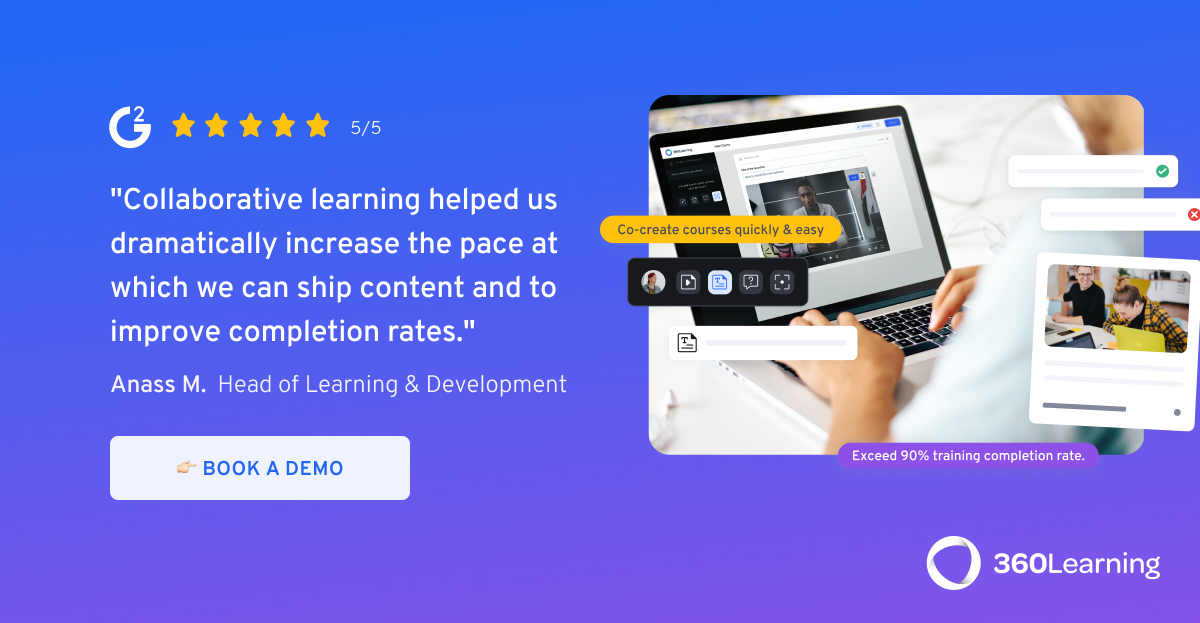The industry average for eLearning course completion rates is an abysmal 20-30%. Yet, at 360Learning we see an average 91% course completion rate across 2,300+ companies on our platform.
One of the best ways to measure learning engagement is through how many people are completing your courses and programs. The simple truth is that if your employees are not finishing courses, then they're not getting the resources and information they need to learn and grow in their careers—and at your company.
So what are the secrets to boosting engagement across your learning programs? As part of our new insights series, we took a deep dive into what factors increase learner engagement and contribute to higher completion rates.
Read on for some data-driven tips you can start utilizing today to send your completion rates soaring 🚀.

1. Build collaboration into your course creation
You wouldn’t craft an email blast to your customers without having several stakeholders collaborate, review, and provide feedback before hitting send. So why should publishing a course be any different? When it comes to learning, your employees are your customers after all.
Learners find courses that had internal collaboration during the creation process 2x as useful
But just how much internal collaboration are we talking? We found that rates doubled when a course had at least 3 internal comments between 2 or more people. The conversations could be anything from co-authors strategizing on course content, and/or reviewers giving feedback to the authors of the course.
The main takeaway: Adding co-authors to your courses will help ignite ideas, improve content, and create an easy landscape for collaboration. Get additional eyes on newly created courses by assigning reviewers who can walk through it with a learner’s lens and provide useful feedback and edits.

2. Refresh courses to improve their relevance
Fact: Business moves fast. That means your learning catalog can get outdated quickly. If learners are repeatedly coming across information that isn’t useful or relevant, there’s a good chance that they’ll start losing confidence in the courses they are asked to take. You can pretty much count on declining engagement, completion rates, and overall satisfaction from employees in your learning programs. Recovering from this is no easy feat.
Refreshing content in your learning catalog is vital to keep employees engaged and finishing courses. The data speaks for itself:
Learners find courses that are updated regularly 27% more useful
The good news is that it’s incredibly easy to know when content needs to be updated. With Reactions in 360Learning, learners can seamlessly flag outdated or irrelevant content with the Reaction ‘I don’t get it’ or ‘This is outdated’ and can rate a course’s relevance as useful or not useful to them. Authors and L&D teams are instantly notified and able to act lightning fast to update their courses. With an instant feedback loop, the right courses are updated and kept fresh, so learners get the information they need while keeping engagement high.
Pro-tip: Check your course dashboard to see the Reaction Score for courses across your catalog. You can sort by Score, or specific Reactions like ‘I don’t get it’ or ‘This is outdated’. If learners provide additional context, you can see their feedback in your feedback inbox. Once the course has been updated, ping the learner to let them know their feedback was heard and has been addressed. It’s a quick step that can make a huge difference in increasing their confidence in the learning catalog and the experience for future learners.

3. Engage learners with questions
No one likes to learn by just being lectured at, or what we’ve come to know as passive learning. The way to engage and excite learners is through active learning; a process where learners are involved in constructing their own understanding of a subject, often through group interactions and applied thinking.
Incorporating activities throughout courses is one of the best ways to integrate active learning and improve not only comprehension, but engagement and completion rates.
In 360Learning, there are many different ways to engage learners throughout courses. But what types of activities perform best? We analyzed all activity types within courses and compared them against positive Reactions to that activity (‘I like it’, ‘I learned something’, and ‘I’ll use this’). The results were unsurprising:
Questions provoke the highest amount of positive Reactions at a staggering 75.9% conversion
In other words, 75.9% of the time that a question was asked in a course, a learner engaged and reacted positively to it. Let’s dig even deeper. Across question types, there were two with the highest engagement: True/False and Hotspot questions.
Asking questions throughout the learning journey has a ton of great benefits. They’re a great way to gauge comprehension of content, helping L&D teams better understand and adjust courses to improve understanding of certain concepts. Questions also improve retention by helping learners recall the information they just absorbed.
Put it into action: Try incorporating more questions throughout your courses to improve retention and learner satisfaction. Experiment with different question types to see what your learners like best.
So what are you waiting for? You can instantly improve your completion rates by ensuring collaboration during course creation, updating your courses regularly, and incorporating more questions throughout the learner’s journey. These real data insights prove that Collaborative Learning not only works, but is vital for increasing learning engagement and completion rates across your organization.
Interested in learning more about how Collaborative Learning can work for you? Request a demo of our platform today.



